Performance Art Where Woman Let People Draw on Her
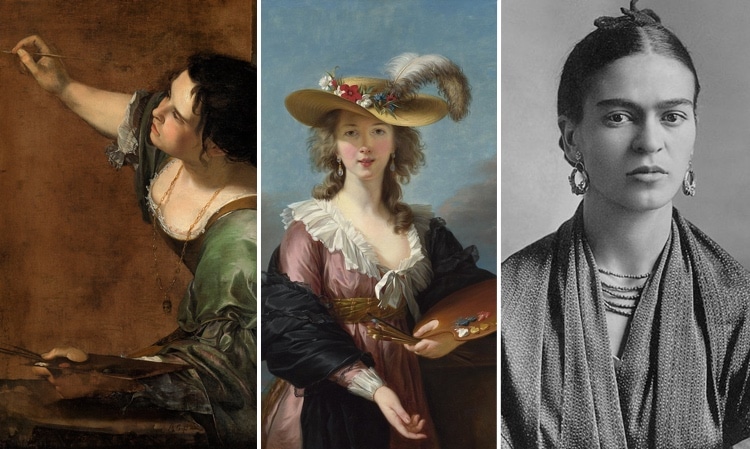
The history of art is littered with the names of swell men—Leonardo da Vinci, Vincent Van Gogh, Pablo Picasso, etc. Only what virtually the women who have helped shape the globe's visual history? As with many other fields, women were historically discouraged from pursuing a career in the arts, nonetheless at that place are many incredible females who persevered. These famous female artists have more in common than their gender and career path—they are all trailblazers in their own right, with many breaking barriers in their personal and public life.
Of course, these women would most likely exist displeased to be included in a listing of female person painters, preferring to exist valued as artists exterior of their gender. Unfortunately, equally women continue to fight for equality in all fields, these infrequent artists are often still mentioned in terms of their gender. Luckily, more than than ever, these women of distinction are existence held up against their male peers and recognized positively for their contributions to fine art history. Organizations like Advancing Women Artists work to ensure that the female talent of the by doesn't get left out of the history books.
A look at some of the great female artists of the past is likewise a timeline of art history. Women take been leading figures in every artistic movement from the Italian Renaissance to American Modernism and across. By weaving our way through art history—from a 16th-century courtroom painter for Male monarch Philip 2 to the 20th-century icon that is Frida Kahlo—permit'south take a wait at the strength, graphic symbol, and talent of these exceptional women.
If you're an fine art lover, here are 12 famous female person artists that you demand to know.
Sofonisba Anguissola (1532–1625)
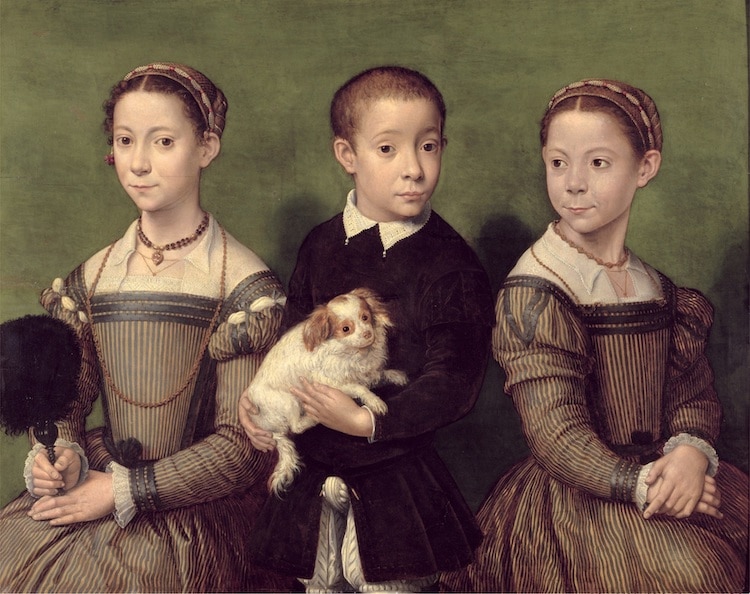
"Iii Children with a Dog" past Sofonisba Anguissola. circa 1570-1590. (Photograph: Wikimedia, Public domain)
Painter Sofonisba Anguissola was a trailblazer during the Italian Renaissance. Built-in into a relatively poor noble family, her male parent made sure that she and her sisters had a well-rounded teaching that incorporated fine art. This included apprenticeships with respected local painters. This set a precedent for futurity female artists, who until that betoken typically only apprenticed if a family unit member had a workshop. Anguissola's talent defenseless the eye of Michelangelo, with whom she carried on an informal mentorship through the exchange of drawings.
Though, as a female creative person, she was not immune to study beefcake or practice drawing models due to its perceived vulgarity, she still managed to have a successful career. Much of her success was owed to her role as a painter in the court of Rex Philip II of Spain. Over the course of xiv years, she adult her skills for official courtroom portraiture equally well every bit more intimate portraits of nobility. Her paintings are known for capturing the spirit and vibrance of her sitters and tin can at present be found in collections around the earth.
Artemisia Gentileschi (1593–1653)
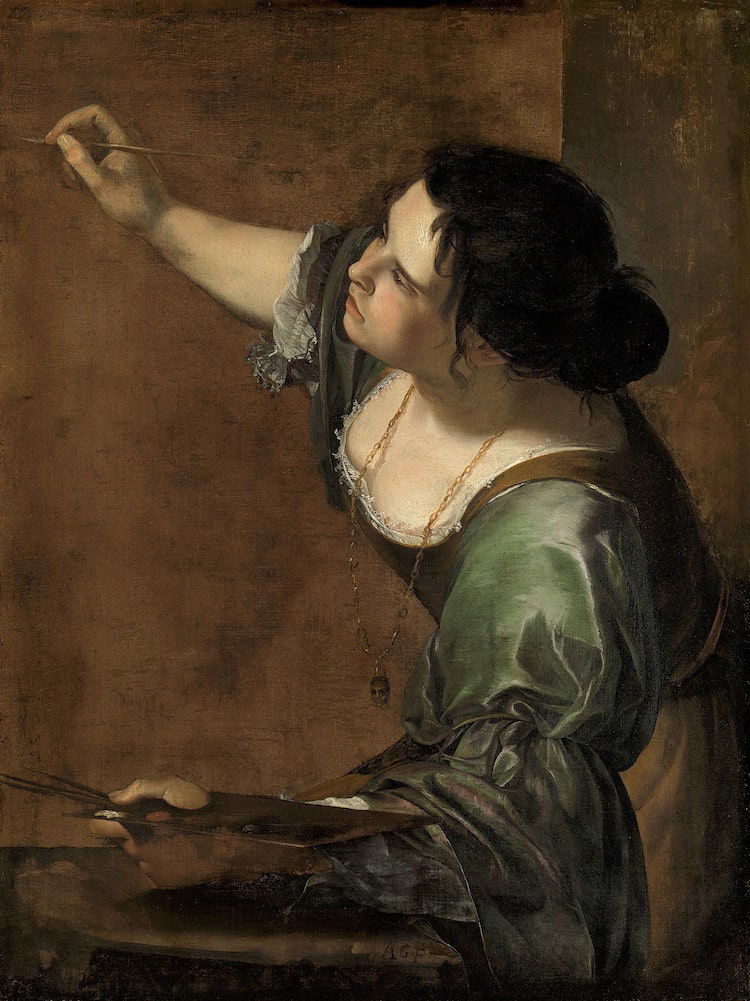
"Self-Portrait as the Allegory of Painting" past Artemisia Gentileschi. 1638–39. (Photo: Wikipedia, Public domain)
Equally the daughter of an achieved painter, Artemisia Gentileschi was afforded admission to the art globe at a young age. Early on she was in her father's workshop mixing paints and he supported her career when he noted that she was exceptionally gifted. As a noted painter of the Italian Baroque period, Artemisia Gentileschi did not let her gender hold her back from her subject matter. She painted big-scale Biblical and mythological paintings, just like her male person counterparts and was the first woman accepted to the prestigious Art University in Florence.
Her legacy is sometimes overshadowed past her biography, with her bloody depictions of Judith and Holofernesofttimes being interpreted through the lens of her rape at the easily of a fellow artist. However, her talent is undeniable and she continues to be recognized for her realistic delineation of the female person form, the depth of her colors, and her hit apply of calorie-free and shadow.
Judith Leyster (1609–1660)
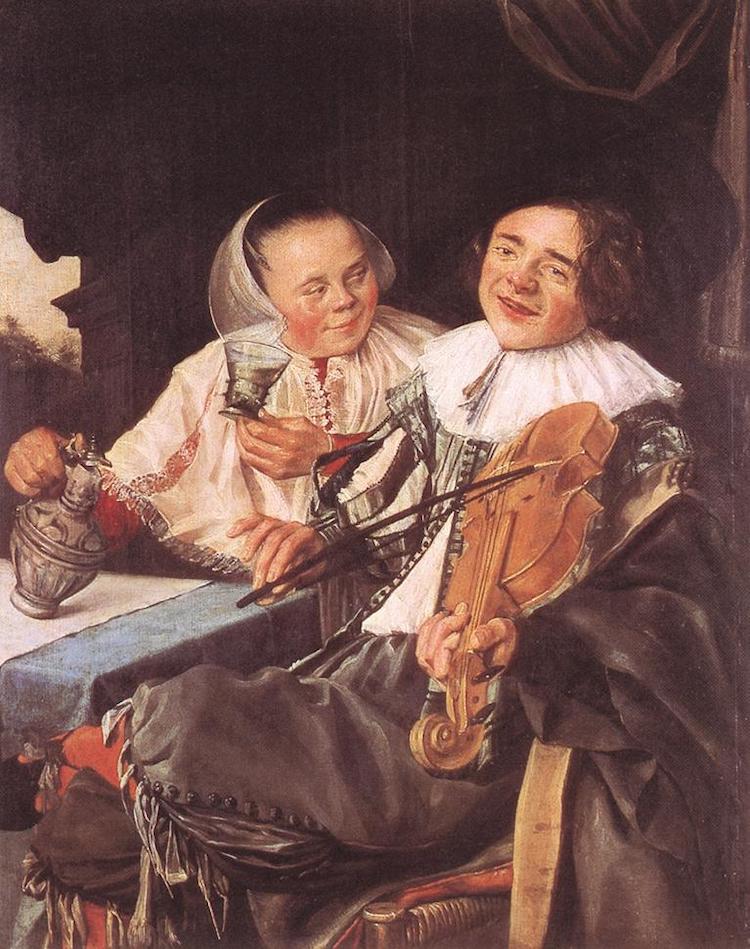
"The Happy Couple" by Judith Leyster. 1630. (Photo: Wikipedia, Public domain)
Born in Haarlem, Judith Leyster was a leading artist during the Dutch Golden Age. Typical of Dutch artists during this period, Leyster specialized in genre paintings, still life, and portraits. The details backside her artistic training are unclear, but she was one of the first women admitted to the painter'southward guild in Haarlem. She later ran a successful workshop with several male apprentices and was known for the relaxed, informal nature of her portraits.
While she was quite successful during her lifetime, her reputation suffered after her death due to unfortunate circumstances. Her entire oeuvre was passed off every bit work either by her contemporary Frans Hals or by her husband. In many cases, her signature was covered by collectors looking to brand a profit due to the high market value of Frans Hals' work. Only in the belatedly 19th century were these errors discovered and scholars began to gain a renewed appreciation for Leyster's skill as an artist.
Élisabeth Vigée Le Brun (1755–1842)
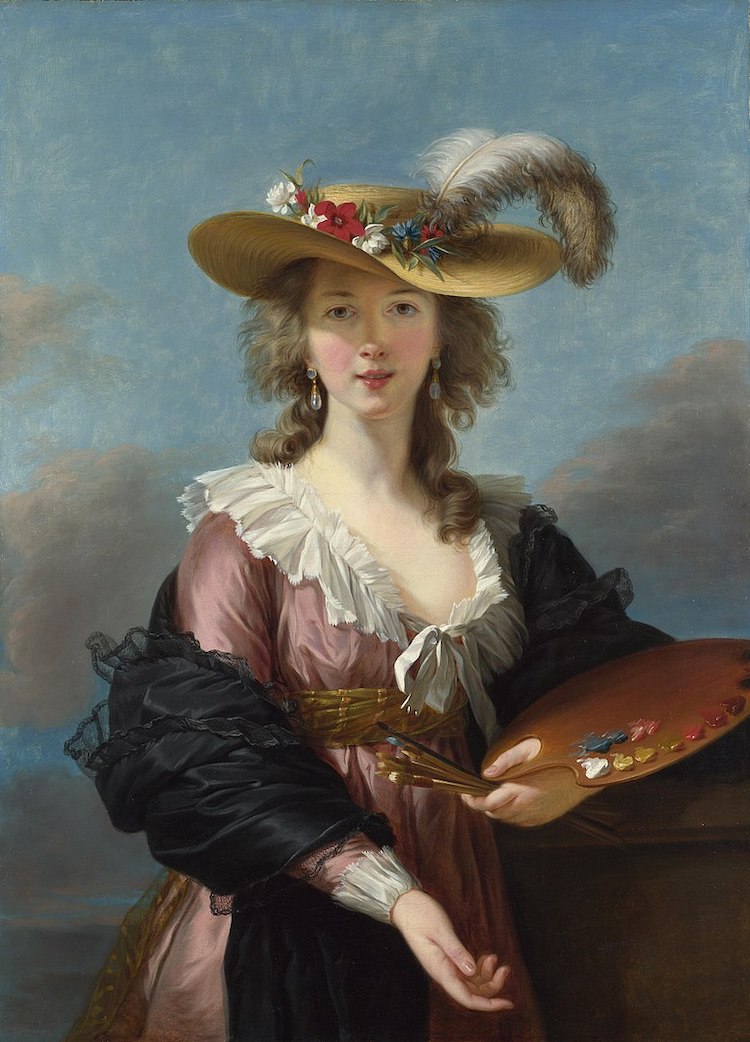
"Self-Portrait in a Straw Hat" past Élisabeth Vigée Le Brun. 1782. (Photo: Wikipedia, Public domain)
French portrait artist Élisabeth Vigée Le Brun created an impressive body of work totaling almost i,000 portraits and landscape paintings. As the daughter of a painter, she received early on teaching from her father and was painting portraits professionally by the fourth dimension she was a teenager. Her big career break came when she was named as Marie Antoinette's portrait painter and she was subsequently granted entry to numerous art academies.
Her paintings bridge the gap between the theatrical Rococo style and more than restrained Neoclassical menstruation. She enjoyed connected success in her career, even while in exile afterward the French Revolution, every bit she was a favorite painter of the elite across Europe. Sitters enjoyed her ability to put them at ease, which led to portrait paintings that were lively and lacking stiffness. The natural, relaxed style of her portraits was considered revolutionary at a time when portraiture often called for formal depictions of the upper classes.
Rosa Bonheur (1822–1899)
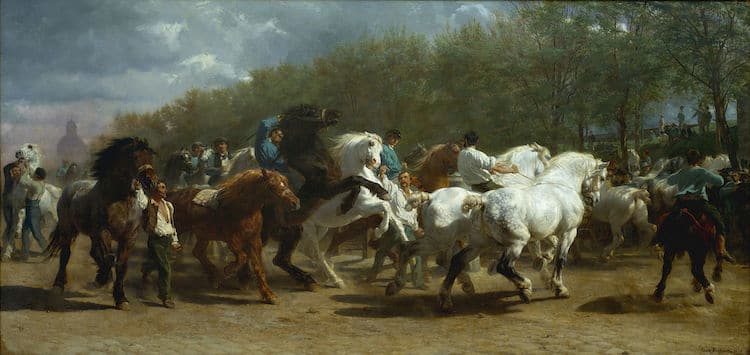
"The Horse Fair" past Rosa Bonheur. 1852–55. (Photograph: Wikipedia, Public domain)
Like many female artists, Rosa Bonheur'due south father was a painter. The French Realist painter is considered one of the virtually famous female artists of the 19th century, known for her large-format paintings that featured animals. She exhibited regularly at the acclaimed Paris salon and found success away in both the United states of america and Britain. Bonheur spent a great amount of fourth dimension sketching live animals in motion, accounting for her remarkable ability to capture their likeness on canvas.
Bonheur is also historic for breaking gender stereotypes. From the mid-1850s onward she wore men's dress, even obtaining police authorization to practise and then. Though she was often criticized for wearing trousers and loose blouses, she continued to don them throughout her life, citing their practicality when working with animals. She was also an open up lesbian, kickoff living with partner Nathalie Micas for over 40 years and and then, after Micas' decease, forging a relationship with American painter Anna Elizabeth Klumpke. Past living her life openly in an era when lesbianism was disparaged by the government, Bonheur staked her claim as a groundbreaking individual both in her career and her personal life.
Berthe Morisot (1841–1895)
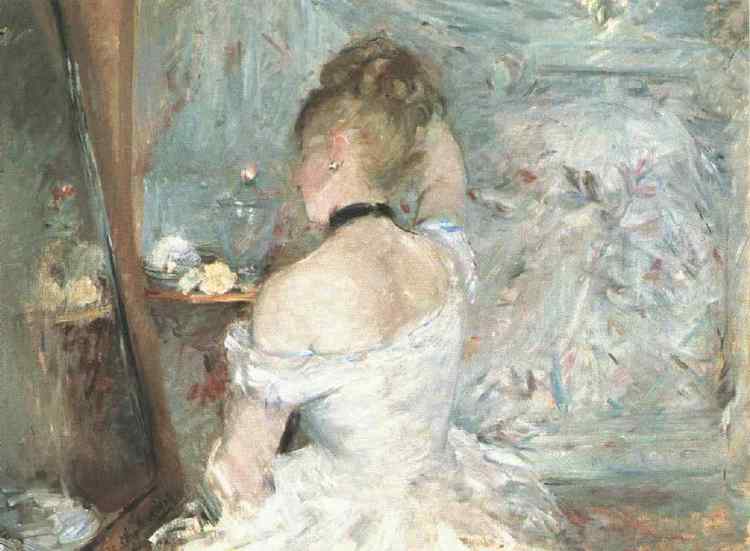
"Lady at her Toilette" by Berthe Morisot. 1875. (Photo: Wikipedia, Public domain)
Considered one of the great female Impressionists, Berthe Morisot had art running through her veins. Born into an aloof French family, she was the great-niece of celebrated Rococo painter Jean-Honoré Fragonard. Initially, she exhibited her work at the respected Paris Salon before joining the first Impressionist showroom with Monet, Cézanne, Renoir, and Degas. Morisot has a specially close relationship with Édouard Manet, who painted several portraits of her, and she eventually married his brother.
Her art oftentimes focused on domestic scenes and she preferred working with pastels, watercolor, and charcoal. Working mainly in small scale, her lite and airy work was often criticized equally beingness also "feminine." Morisot wrote near her struggles to be taken seriously as a female person artist in her periodical, stating "I don't recollect there has ever been a man who treated a adult female as an equal and that's all I would accept asked for, for I know I'g worth as much as they."
Mary Cassatt (1844–1926)
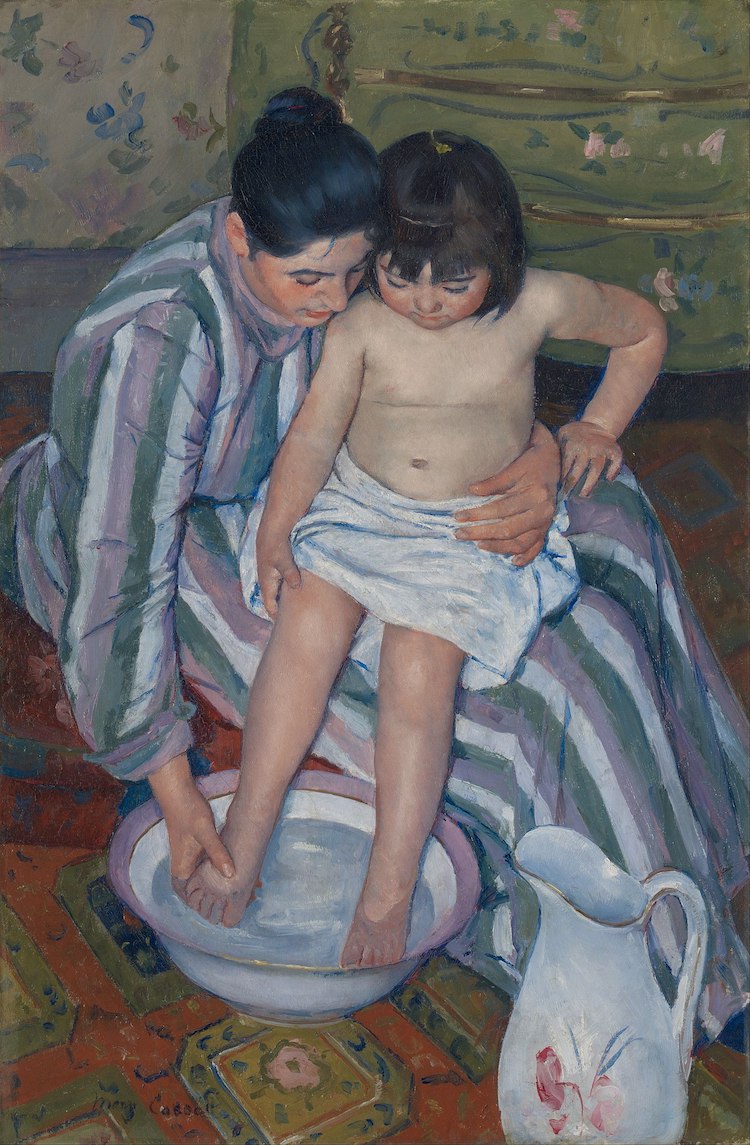
"The Kid's Bath" by Mary Cassatt. 1893. (Photo: Wikipedia, Public domain)
American painter Mary Cassatt spent her adult life in France, where she became an integral part of the Impressionist group. Cassatt was born into an affluent family who get-go protested against her desire to become an creative person. She eventually left art schoolhouse after being frustrated by the separate treatment that the female person students received—they couldn't apply live models and were left drawing from casts.
Upon moving to Paris at age 22, Cassatt sought a private apprenticeship and spent her gratuitous time copying Old Primary paintings in the Louvre. Cassatt's career was already taking off when she joined the Impressionists and forged a lifelong friendship with Degas. At the aforementioned time, she was outspoken in her dismay at the formal art system, which she felt required female artists to flirt or befriend male patrons in order to move ahead. She created her ain career path with the Impressionists, mastering pastels to create soft, calorie-free work that often highlighted women interim as caretakers. Throughout her life, Cassatt continued to support equality for women, even participating in an exhibition in support of women's suffrage.
Georgia O'Keeffe (1887–1986)
Every bit an artist at the forefront of American Modernism, Georgia O'Keeffe is one of the virtually historic female artists in history. Her early drawings and paintings led to bold experiments in brainchild, with her focus on painting to express her feelings ushering in an era of "Art for Art's Sake." During her lifetime, her career was intertwined with her married man, Alfred Stieglitz. While the renowned photographer consort ideas that American art could equal that of Europe and that female painters could create fine art just as powerful as men, he also hindered interpretation of her work.
Stieglitz viewed creativity as an expression of sexuality and these thoughts, coupled with his intimate portraits of O'Keeffe, pushed forward an idea that her close upwards paintings of flowers were metaphors for female person genitalia. It'south a concept that the artist has ever denied, though her work is undoubtedly sensual. O'Keeffe spent much of her career combatting her art's estimation solely every bit a reflection of her gender. Throughout her life she refused to participate in all-female person art exhibitions, wishing to be defined just as an creative person, gratuitous from gender.
Tamara de Lempicka (1898–1980)

Polish creative person Tamara de Lempicka is known for her highly stylized portraits and nudes that exemplify the Art Deco era. De Lempicka spent much of her career in France and the United States, where her piece of work was favored by aristocrats. One of her almost famous paintings,Cocky-Portrait in a Green Bugatti, exemplifies the absurd and detached nature of De Lempicka'due south figures. In the work, which was created for the cover of a High german mode magazine, De Lempicka exudes independence and inaccessible beauty.
Her paintings often independent narratives of desire, seduction, and modern sensuality, making them revolutionary for their time. De Lempicka enjoyed success until the outbreak of Globe War II, but there was a resurgence of interest in her piece of work as Art Deco became popular again in the 1960s. Her immediately recognizable style makes her a particular favorite among fans of Art Deco painters and today her work is more popular than e'er, with Madonna being a known collector of her paintings.
Frida Kahlo (1907–1954)
Currently, there's no other 20th-century female person artist with a name as recognizable atFrida Kahlo. While the drama of her tragic accident as a immature woman and her tumultuous relationship with hubby Diego Rivera accept sometimes overshadowed her artistic abilities, in that location is no denying the power of her painting. She is particularly known for her self-portraits, which deal with themes of identity, suffering, and the man trunk.
Though she was sometimes written about solely every bit "Diego Rivera's married woman" during her lifetime, her artwork has merely gained momentum since her expiry. The nigh famous Frida Kahlo paintings belong to important art museums around the globe, while she has gained status as a champion of feminists, Chicanos, and the LGBT community.
Helen Frankenthaler (1928–2011)
Growing up in Manhattan, Helen Frankenthaler pursued painting studies at the Dalton Schoolhouse and Bennington College. She began her extensive exhibition career in 1952, with the display of her painting Mountains and Body of water. Having studied under the artist Hans Hoffman, as a young artist she became an of import effigy in the abstruse expressionism creative motility. Her paintings featured colorful, organic shapes. In the early on years of her career, these compositions tended to be centralized on the sheet. Past the 1960s, Frankenthaler's works oft encompassed the entire sail. Her vi-decades-worth of piece of work displays a constant evolution in style.
Today, Frankenthaler is remembered as a pioneer of color field painting—a style which features large swaths of colour as the painting's "subject area." To achieve the effect of a wash of vivid color, Frankenthaler thinned her paints with turpentine earlier applying them to the unprimed sail. The event of this "soak stain" method was an almost-watercolor-like advent with color congenital in organic layers. Hers and similar works were included in the famous 1964 exhibit curated by art critic Clement Greenberg, entitled Postal service-Painterly Abstraction. Today, her piece of work can be found in virtually major American art museums.
June Leaf (1929–Present)
Born and raised in Chicago, June Leafage briefly trained at the IIT Plant of Design before setting out to pursue her ain independent learning in Paris at the tender age of 18. In 1954, she returned to Illinois to obtain her bachelor'due south and primary'due south degrees in Fine art Instruction. However, in 1958 she returned to Paris with funding for her artwork from a Fulbright. Over the years, she developed an allegorical manner across several mediums. Through pen and ink drawings, canvas paintings, and kinetic sculpture, Leaf'southward work embraces the abstract and unusual. Her work often features the human body—often incorporating her ain imagined easily into the work.
Foliage and her husband—filmmaker and photographer Robert Frank—split their time between a Bleeker Street flat in New York and fishing cottage in Nova Scotia. In 2016, the Whitney Museum of American Fine art held a retrospective on her work entitled June Leafage: Idea Is Space. Although Frank passed away in 2019, Leaf nevertheless creates. In a 2016 interview with Women's Wear Daily, she described her work as a process of searching. She said, "Possibly I don't want public acclaim. I want to survive with that integrity that is so precious to me. The fact that I could make that drawing [gesturing toward an easel] made me think 'Oh proficient, you're all the same a scientist who can invent something that goes with your life.'"
This article has been edited and updated.
Related Manufactures:
Online Database Features Overlooked Female Artists from 15th-19th Centuries
Empowering Art Book Highlights Female Artists Overlooked by Museums
9 Bold & Powerful Women Who Shaped the Art World
eight Iconic Artists and the Inspiration Behind Their Favorite Subjects
Source: https://mymodernmet.com/famous-female-painters-art-history/
0 Response to "Performance Art Where Woman Let People Draw on Her"
Enviar um comentário